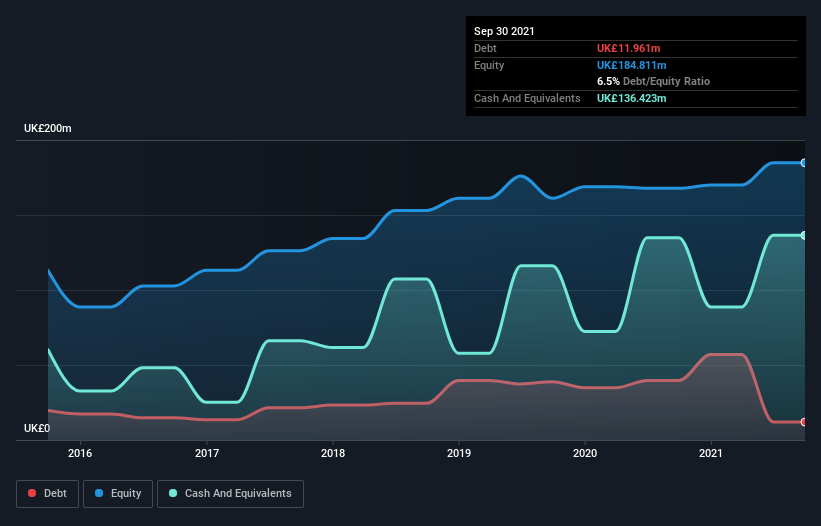Warren Buffett famously said, 'Volatility is far from synonymous with risk.' It's only natural to consider a company's balance sheet when you examine how risky it is, since debt is often involved when a business collapses. We note that Watkin Jones Plc (LON:WJG) does have debt on its balance sheet. But the more important question is: how much risk is that debt creating?
When Is Debt Dangerous?
Debt and other liabilities become risky for a business when it cannot easily fulfill those obligations, either with free cash flow or by raising capital at an attractive price. If things get really bad, the lenders can take control of the business. While that is not too common, we often do see indebted companies permanently diluting shareholders because lenders force them to raise capital at a distressed price. By replacing dilution, though, debt can be an extremely good tool for businesses that need capital to invest in growth at high rates of return. When we think about a company's use of debt, we first look at cash and debt together.
View our latest analysis for Watkin Jones
What Is Watkin Jones's Net Debt?
As you can see below, Watkin Jones had UK£12.0m of debt at September 2021, down from UK£39.7m a year prior. But on the other hand it also has UK£136.4m in cash, leading to a UK£124.5m net cash position.

A Look At Watkin Jones' Liabilities
Zooming in on the latest balance sheet data, we can see that Watkin Jones had liabilities of UK£109.5m due within 12 months and liabilities of UK£136.3m due beyond that. Offsetting these obligations, it had cash of UK£136.4m as well as receivables valued at UK£30.9m due within 12 months. So its liabilities total UK£78.5m more than the combination of its cash and short-term receivables.
Since publicly traded Watkin Jones shares are worth a total of UK£582.4m, it seems unlikely that this level of liabilities would be a major threat. Having said that, it's clear that we should continue to monitor its balance sheet, lest it change for the worse. While it does have liabilities worth noting, Watkin Jones also has more cash than debt, so we're pretty confident it can manage its debt safely.
And we also note warmly that Watkin Jones grew its EBIT by 10% last year, making its debt load easier to handle. The balance sheet is clearly the area to focus on when you are analysing debt. But it is future earnings, more than anything, that will determine Watkin Jones's ability to maintain a healthy balance sheet going forward. So if you want to see what the professionals think, you might find this free report on analyst profit forecasts to be interesting.
Finally, a company can only pay off debt with cold hard cash, not accounting profits. While Watkin Jones has net cash on its balance sheet, it's still worth taking a look at its ability to convert earnings before interest and tax (EBIT) to free cash flow, to help us understand how quickly it is building (or eroding) that cash balance. During the last three years, Watkin Jones produced sturdy free cash flow equating to 74% of its EBIT, about what we'd expect. This cold hard cash means it can reduce its debt when it wants to.
Summing up
While Watkin Jones does have more liabilities than liquid assets, it also has net cash of UK£124.5m. And it impressed us with free cash flow of UK£61m, being 74% of its EBIT. So is Watkin Jones's debt a risk? It doesn't seem so to us. When analysing debt levels, the balance sheet is the obvious place to start. But ultimately, every company can contain risks that exist outside of the balance sheet. Be aware that Watkin Jones is showing 1 warning sign in our investment analysis , you should know about...
If, after all that, you're more interested in a fast growing company with a rock-solid balance sheet, then check out our list of net cash growth stocks without delay.
Valuation is complex, but we're here to simplify it.
Discover if Watkin Jones might be undervalued or overvalued with our detailed analysis, featuring fair value estimates, potential risks, dividends, insider trades, and its financial condition.
Access Free AnalysisHave feedback on this article? Concerned about the content? Get in touch with us directly. Alternatively, email editorial-team (at) simplywallst.com.
This article by Simply Wall St is general in nature. We provide commentary based on historical data and analyst forecasts only using an unbiased methodology and our articles are not intended to be financial advice. It does not constitute a recommendation to buy or sell any stock, and does not take account of your objectives, or your financial situation. We aim to bring you long-term focused analysis driven by fundamental data. Note that our analysis may not factor in the latest price-sensitive company announcements or qualitative material. Simply Wall St has no position in any stocks mentioned.
About AIM:WJG
Watkin Jones
Engages in the development and the management of properties for residential occupation in the United Kingdom.
Excellent balance sheet with reasonable growth potential.
Market Insights
Community Narratives



